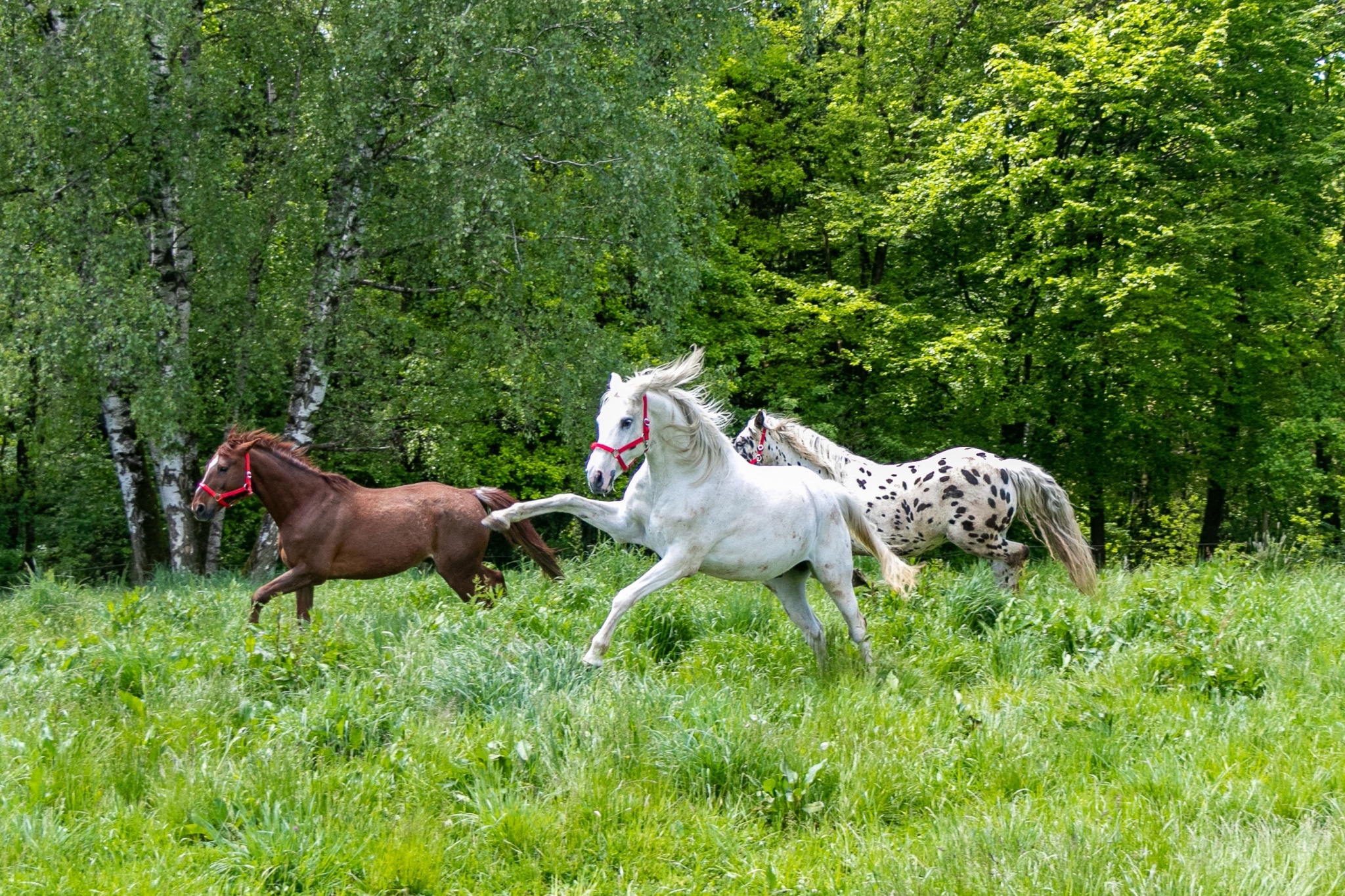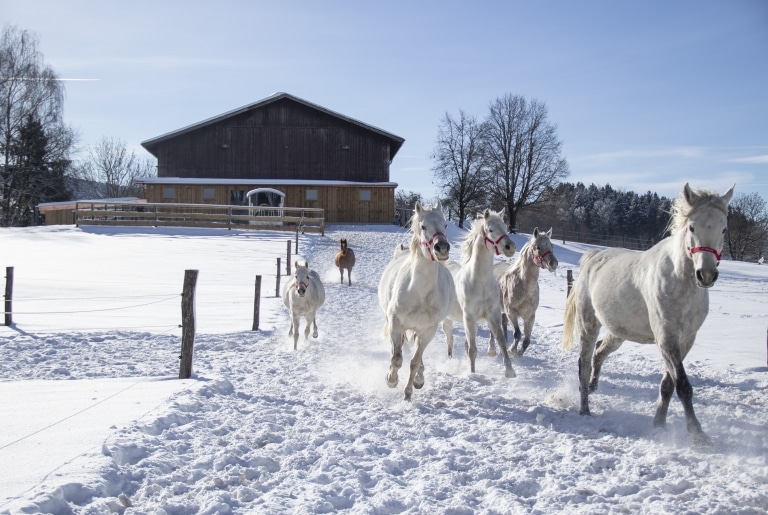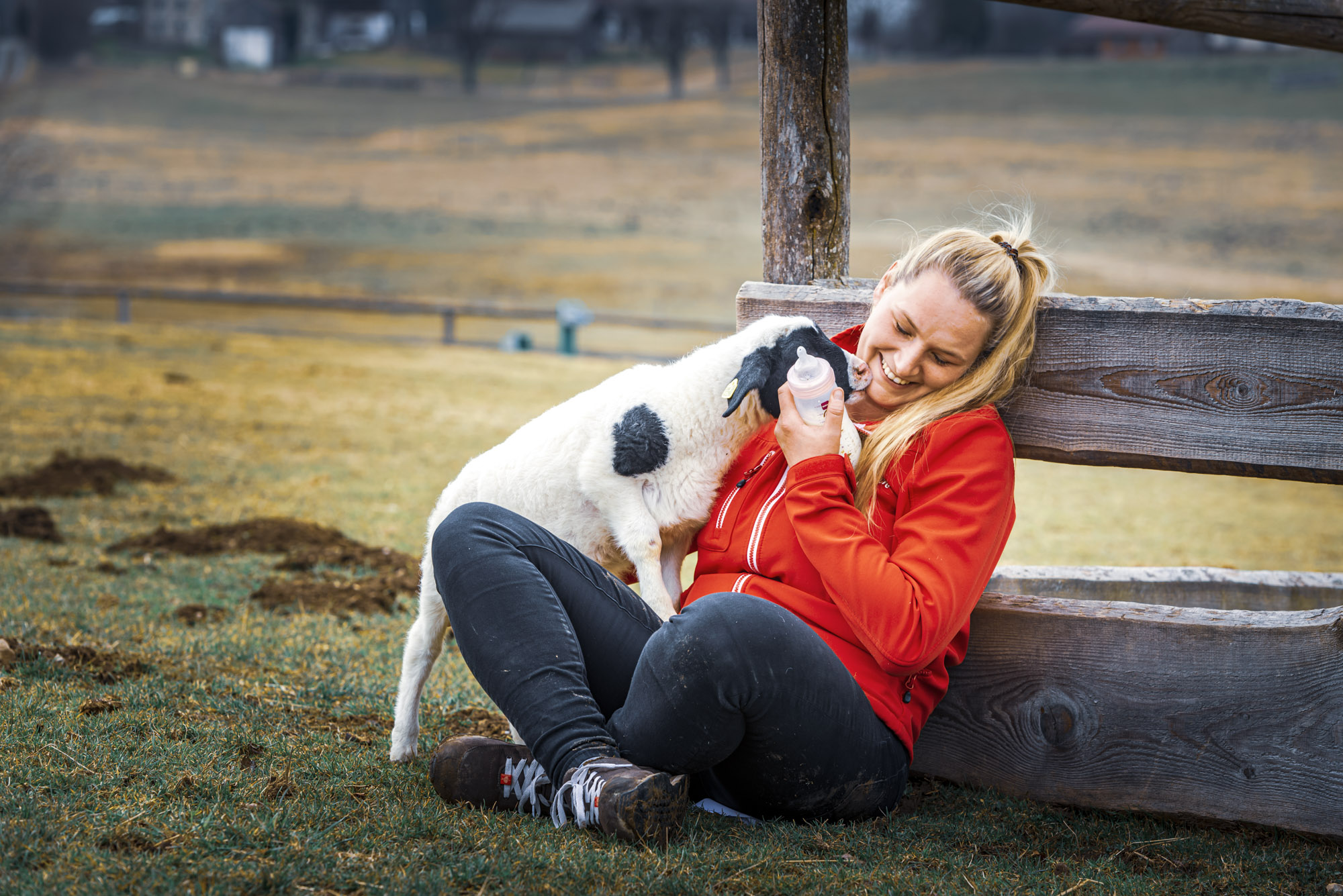
Pferdehaltung
Eine wesentliche Rolle für die Steigerung der Lebensqualität
Eine wesentliche Rolle für die Steigerung der Lebensqualität bei spielt die Pferdehaltung. Nach wir vor ist das Wissen über die bedarfsgerechte Fütterung bei alten Pferden nicht ausreichend vorhanden. Umso wichtiger ist es, ein gesundes Ökosystem zwischen Grasland und Weidetiere zu schaffen, um das Wohlbefinden alter Pferde dauerhaft verbessern zu können.
Grundlage/Ausgangspunkt: Moderne Pferdehaltungsformen zeichnen sich dadurch aus, dass die Tiere durch räumliches Trennen von Flächen in verschiedene Funktionsbereiche zu stetiger Bewegung motiviert werden. Bei den sogenannten Paddock-Trails handelt es sich um Pferdeanlagen im Freien, welche das erwähnte Prinzip besonders konsequent umsetzen; Aufenthaltsbereiche wie Liegehütte, Wasserstelle und Futterraufe sind entfernt voneinander angelegt und durch Laufgänge verbunden. Das so erreichte naturnahe Bewegungsmuster der Tiere fördert deren Gesundheit und das harmonische Zusammenleben innerhalb von Pferdegruppen.
Zur Schonung der Grasnarbe sowie aus Gründen der Tiergesundheit und der Sicherheit sind diese Laufwege zu befestigen, wenn der Paddock Trail ganzjährig genutzt werden soll. Das steht jedoch den Interessen des Kulturlandschutzes entgegen. Beispielsweisse in der Schweiz erteilen kantonale Raumplanungsbehörden keine oder nur eingeschränkte Bewilligungen für Paddock-Trails mit allwettertauglich befestigten Laufwegen in der Landwirtschaftszone.

Ziel: Um diesen Zielkonflikt zwischen Tierschutz und Kulturlandschutz zu beheben, soll dieses Projekt Lösungen für eine bodenschonende Trail- bzw. Auslaufbefestigung entwickeln, die sowohl den tierschützerischen als auch den raumplanerischen Interessen (keine dauerhafte Beeinträchtigung von wertvollem Kulturland, insbesondere von Fruchtfolgeflächen FFF in der Schweiz) gerecht werden. Hierfür wird die Effektivität ausgewählter Befestigungsvarianten unter Berücksichtigung des Tierwohls, der Vegetation und der Belastungsintensität untersucht. Insbesondere werden die Regeneration und Rekultivierung des Bodens, nach zwei Jahren Belastung durch die Tiere verfolgt.
Zudem erfolgt als Nebenprojekt eine Querschnittsstudie mit Momentaufnahmen von Böden verschiedener bestehender Praxisbetriebe mit Paddock-Trails, um die Auswirkungen der Belastung bei unterschiedlichen Befestigungsmaterialien und Managementmassnahmen zu erfassen.
Neue Erkenntnisse: Der Nebenprojekt «Querschnittsstudie mit Momentaufnahmen von Böden verschiedener bestehender Praxisbetriebe» hat bereits stattgefunden. Es konnten die Laufflächen von 17 Betrieben aus der Schweiz, Deutschland und Luxemburg beprobt werden: Für die Untersuchung der mikrobiellen Biomasse 135 Proben aus einer Tiefe von 0-20 cm, für die Erfassung der Verdichtung 405 Proben aus einer Tiefe von 10, 20 und 30 cm und für die Feststellung des Mikroplastiks im Boden 33 Proben aus einer Tiefe von 10 cm. Die Laboranalysen sind am Laufen.
Ausblick: Die baulichen Massnahmen (Installation Laufwege, Weideunterstände, Futterraufen und Tränken, Einzäunung) sind laufend geplant, sobald die Baubewilligung vorliegt. Auffuhr der 20 Versuchspferde und somit Beginn der systematischen Belastung der Bodenbefestigung dürfte ab August 2022 möglich sein, abhängig von den Wetterbedingungen.
Projektleitung: Das Projekt stellt eine interdisziplinäre Zusammenarbeit der Bodenspezialisten Agroscope-Reckenholz (Gruppe Dr. Thomas Keller), der Pferdehaltungsspezialisten Agroscope-Avenches (Gruppe Dr. Iris Bachmann) sowie des Departements für Umweltwissenschaften ETH Zürich (Gruppe Prof. Dr. Sebastian Dötterl) dar.
Auf modernen Grasflächen leiden viele Pferde unter Wohlstandserkrankungen. Diese Grasländer stammen überwiegend aus der Rinderhaltung. Für Pferde sind sie zu reich an Energie und Eiweiß. Keineswegs handelt es sich um Steppengräser. Zudem setzt sich in der Wissenschaft immer mehr die Erkenntnis durch, dass die Vorfahren unserer Pferde keineswegs nur aus der Steppe kamen, sondern vor allem die durch Fraß großer Pflanzenfresser geschaffenen Savannen bevölkerten. Das kleinteilige Mosaik der Vegetation in Savannen bietet neben Wildgräsern viele Heilkräuter, Witterungsschutz unter Bäumen und mineralreiches Zusatzfutter durch das Laub von Büschen. Die Projekte auf Gut Aiderbichl erfassen den momentanen Zustand und die Eigenschaften der Flächen, leiten daraus deren mögliches Potenzial ab und suchen nach Wegen, wie eine naturnahe, artenreiche Futterfläche zum Nutzen der vorhandenen Pferde geschaffen werden könnte.
Artenvielfalt und toxische Endophyten auf den Wiesen und Weiden
- Eine Grundlage für die Verbindung von Artenschutz und Tierschutz
- Potentielle Gefahren und Verbesserungspotential erkennen
Grundlage / Ausgangspunkt: Gut Aiderbichl hat das erklärte Ziel, nicht nur den Tierschutz zu fördern, sondern auch den Artenschutz.
Mikroskopische Pilze, die symbiotisch im Pflanzengewebe leben – sogenannte „Endophyten“ – nehmen oft Wiesengräser als Wirt. Sie machen die Pflanzen robuster und produktiver, können aber auf Dauer die Gesundheit der Weidetiere schädigen; Pferde reagieren besonders empfindlich auf die produzierten Toxine (Giftstoffe). Die Aktivität und Auswirkungen der Endophyten auf die Weidetiere hängen von diversen ökologischen Faktoren ab, welche auch die Artenvielfalt auf Wiesen und Weiden beeinflussen. Solche Lebensräume haben im letzten Jahrhundert grosse Biodiversitätsverluste erlitten, die vor allem auf Intensivierung, insbesondere Überdüngung und Überweidung, zurückzuführen sind.
Während in Übersee (v.a. Nordamerika, Neuseealand) das Problem toxischer Endophyten schon lange bekannt und intensiv untersucht ist, wurde es in Europa lange wenig beachtet. Ausserdem ist die ökologische Bedeutung dieser Assoziationen nach wie vor unklar.
In diesem Sinne wurde eine internationale Studie lanciert, die einerseits eine Datengrundlage zu den Auswirkungen von toxischen Grasendophyten auf Weidetiere liefern soll, anderseits die Biodiversität der Flächen Gut Aiderbichls untersucht.
Ziele: Auf diversen Standorten von Gut Aiderbichl in Deutschland, Österreich, Frankreich und Ungarn werden Wiesen und Weiden vegetationsökologisch untersucht, und pflanzliche Proben für toxikologischen Laboranalysen gesammelt. Das Projekt soll somit einen Einblick in die botanische Artenzusammensetzung, ökologische Standortsverhältnisse und Vorkommen toxischen Endophyten in den untersuchten Standorten geben. Damit kann das ökologische Potential der genutzten Wiesen und Weiden künftig zur Entfaltung gebracht werden, und gleichzeitig eine auf den Bedürfnissen der Tiere angepassten Ernährung sichergestellt werden.
Ergebnisse: Aus dem ersten Arbeiten von 2021 konnten bereits wertvolle Erkenntnisse gewonnen werden:
Arten, die sich durch häufige Symbiose mit toxischen Endophyten auszeichnen, wurden in fast allen Aufnahmeflächen beobachtet, und betrugen im Durchschnitt ca. ein Drittel der Gesamtdeckung der Vegetation. Das Vorkommen toxischer Endophyten konnte durch Laboranalysen an zwei Standorten in Österreich und Frankreich bestätigt werden, mit Rot-Schwingel und Deutschem Weidelgras als Wirten. Weiter konnte die Häufigkeit von für Pferde giftigen Pflanzen (bspw. Gundelrebe und Scharfem Hahnenfuss) auf den untersuchten Standorten quantifiziert werden, und besonders problematische Bereiche identifiziert werden.
Die Aufnahmeflächen waren an allen bisher untersuchten Standorten artenarm im Durchschnitt, bedingt vermutlich durch intensive Nutzung. Allerdings sind gewisse Naturwerte vorhanden, belegt durch das Vorkommen vereinzelter gefährdeter oder potenziell gefährdeter Arten sowie punktuell überdurchschnittliche Artenzahlen auf Pferdeweiden. Diese Untersuchung liefert somit eine Grundlage für die Konzeption von Massnahmen zur Schonung und Aufwertung der Wiesen und Weiden der Flächen Gut Aiderbichls.
Ausblick: Das Projekt wird 2022 fortgeführt, mit einem Fokus auf Mähwiesen unterschiedlicher ökologischer Qualität. Diese Untersuchung sollte eine laufende Studie zum Ernährungswert des gewonnenen Heus ergänzen. Weiter werden auf Basis der 2021 gewonnenen Erkenntnisse ökologische Aufwertungsmassnahmen in Gut Aiderbichl Frankreich geplant, welche eine langfristige Wirkungskontrolle vorsieht.
Publikationen: Seiler, H. & Dengler, J. 2022. Vegetationskundliche Untersuchung von Grasländern in Europa zur Quantifizierung des Problems toxischer Gefässpflanzen und toxischer endophytischer Pilze für Weidetiere, insbesondere Pferde. ZHAW, Wädenswil
Projektleitung: Forschungsgruppe Vegetationsökologie (Prof. Jürgen Dengler) an der Zürcher Hochschule für Angewandte Wissenschaften (ZHAW)
Biodiversitätsförderung auf Pferdeweiden – Kräuterreiche Agroforstweiden für ältere Pferde
Grundlage/Ausgangspunkt: Der Klimawandel und der Verlust des Artenvielfalts und Biodiversität unserer Weiden, infolge Intensivierung, sind eine Realität in der Landwirtschaft. Pferdebesitzer sind davon nicht ausgenommen, und Lösungen, die diese Fakten berücksichtigen, werden sehr geschätzt. Gut Aiderbichl, dass viele landwirtschaftlichen Höfen und Weideflächen bewirtschaftet, hat beschlossen, dieses Problem in einem multidisziplinären Projekt anzugehen. Außerdem, sind heutzutage viele Weiden schattenlos und dies stellt insbesondere mit der zunehmenden Klimaerwärmung ein Problem für Pferde dar, denn diese brauchen Schatten um sich vor der Sonne, Insekten und der Wärme zu schützen. Es sind jedoch nicht alle Baumarten gleich gut geeignet um als Agroforstelement auf Pferdeweiden Schatten zu spenden.
Dieses Projekt wurde im Frühjahr 2021 mit einer Analyse und Zusammenstellung von Pflanzenarten und Bäumen gestartet, die sich einerseits für eine Pferdeweide eignen, die einheimische Biodiversität im landwirtschaftlichen Raum erhöhen und auch möglichst resilient gegenüber klimawandelbedingten Witterungsschwankungen sein sollten.
Ziel: Zwei unterschiedliche, artenreiche Pferdeweidesaatgutmischungen wurden speziell entwickelt, mit dem Ziel Biodiversitätsförderung mit einer artgerechten Ernährung für ältere Pferde zu kombinieren. Dazu würde eine Mischung für eher trockenere Verhältnisse und eine Mischung für eher feuchtere Verhältnisse erstellt. Die Kombination dieser beiden Mischungen dient auch für die häufigen schwankenden Witterungsverhältnisse im Klimawandel. Diese Studie wird sich in einem theoretischen Teil auch mit Möglichkeiten der Beschattung von Weiden durch einheimische Baumarten auseinandersetzen.
Neue Erkenntnisse: Auf einem Versuchsfeld wurden diese Weidesaatgutmischungen im Sommer 2021 ausgesät. Eine erste botanische Analyse im Mai 2022 ergab eine ähnlich hohe Artdiversität für beide Mischungen, aber einen doppelt so hohen Anteil an Kräutern in der trockenen im Vergleich zu feuchter Mischung. Im August 2022 soll nun eine zweite botanische Analyse durchgeführt werden, die Weiden gemäht und Qualitätsparametern notiert. In einem Fütterungsversuch werden die Weide beweidet und/oder Heu an Pferde verfüttert werden, um potenzielle Präferenzen von Pferden für die unterschiedlichen Pflanzenmischungen zu untersuchen.
Ausblick: Erste Ergebnisse sind im Dezember 2022 zu erwarten und werden hier veröffentlicht. Eine Aufnahme im Frühjahr 2023 sollte Aufschluss darüber bringen, ob die verwendeten Weidesaatgutmischungen sich stabil etabliert haben und von den Pferden geschätzt werden.
Projektleitung: Sandgrueb-Stiftung
